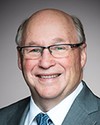Thank you, Ms. Mathyssen.
Dr. Kitchen, please, for five minutes.
Evidence of meeting #92 for Health in the 44th Parliament, 1st Session. (The original version is on Parliament’s site, as are the minutes.) The winning word was surgery.
A video is available from Parliament.
8:40 p.m.
Liberal
8:40 p.m.
Conservative

Robert Gordon Kitchen Conservative Souris—Moose Mountain, SK
Thank you, Mr. Chair.
Wow, thank you all for being here. This is tremendously educational. I feel like I am back in university again. I need an instantaneous note service for everything being covered here. I haven't written this many notes in I do not know how long.
Dr. Jolly, I wish you would have been my professor when I was doing female care 40-some odd years ago. I do appreciate your comments. There is so much knowledge here.
A couple of things have been brought up. We have people watching today who have written and sent a lot of letters to the committee, etc., dealing with the issue of endometriosis, and recognizing it and getting that early diagnosis. You've all talked about that.
Dr. Jolly, you had 10 points. The first one was about education and basically getting into the schools to educate youth on what could possibly happen. I think that is great. The other part you talked about is expanding that medical education. I am going to throw this out there, because one of the things I brought up in the study is the reality that when I went to school, probably only 20% of the students were female. Today at medical schools, it's 50%-plus. That is great to see. We are seeing closer to 48%, 49% female practitioners.
What our constituents who are watching want to know is how we get those doctors who have graduated to take an interest in this subject. I got into sports medicine and various aspects. I streamed into orthopaedics. That was my interest. Everyone tends to do that. But how do we get these doctors to say that this is something they need to know, so when that youth or menopausal lady comes in, they know that this is part of what they need to know.
I will start with you, Dr. Nguyen, and then I will go to Dr. Jolly.
8:40 p.m.
Co-Director, Endometriosis Centre for the Advancement of Research and Surgery, McGill University Health Centre
I think this comes down to CME, continued medical education. To be able to teach, you need the experts.
One of the big things that we need to look at, when we look at endometriosis, is that the care for endometriosis today is very different from what it was 20 years ago. Twenty years ago we had a handful of people who were experts, but like a tree that grows, one branch becomes two becomes three and those divide further. Now, coast to coast, we have a large number of experts.
How do we transfer that knowledge from the experts to the general population and to physicians who have graduated, for instance? That is done through CME. I think it is very important to fund CME so that it entices people to continue offering those courses; but also, if we're able to fund these expert centres, then these centres can then provide teaching and education for a larger number of people and a larger number of trainees.
8:45 p.m.
Conservative

Robert Gordon Kitchen Conservative Souris—Moose Mountain, SK
Thank you.
I apologize. My time is short, and I'm going to go to Dr. Mattatall first and then to Dr. Jolly.
Dr. Mattatall, what are your thoughts on how we can do that?
8:45 p.m.
Obstetrician-Gynecologist, As an Individual
You're speaking to the converted here.
I am a patient who had a laparoscopy at age 19, and I became a gynecologist. Now I teach pelvic pain at the medical school. There are efforts on the ground and advocates like those who are sitting in front of you who are doing this work to educate fellow physicians, medical students and family physicians. We just need to continue to do the work and get the support.
8:45 p.m.
Conservative

Robert Gordon Kitchen Conservative Souris—Moose Mountain, SK
Getting that CME out there is so important, such that people recognize that.
Doctor Jolly, do you think it would be worthwhile to make it a mandatory program in continuing education for practitioners?
8:45 p.m.
Professor Emeritus, Department of Obstetrics and Gynecology, University of Ottawa, As an Individual
Well, there are mandatory programs and you get certain points for going to certain CMEs, so you have to apply for this. It's important to know that if you don't attend a certain number of CMEs, you don't get your professional points. I've not heard of anything very bad that happens if you don't get these points, but they certainly are important.
Through the Society of Obstetricians and Gynaecologists of Canada, obstetrics and gynecology has all kinds of guidelines for everything. There are guidelines for endometriosis, which need to be updated, and we need to then have those, as I said, as a basis for our national action plan, because everything is in that with a review of the literature. The physician is out there and he, she, or they must attend certain numbers of CMEs, and they can do it virtually now. That's one thing we're thankful for that happened with COVID, that we learned how to do this. It was not terribly easy, but we did it.
The CME is excellent now, but in order to attain the CME, our doctors have to be paid for what they do. They don't have enough money sometimes to do all of this, especially the family physicians who are out there struggling with too many patients and too much of a load. Of course, now there's the rule in Ontario of one problem per visit, so if you have two problems, then you have to make another appointment, and this is such a silly thing. There are many areas that are working now, but we have to act on those.
8:45 p.m.
Liberal

The Chair Liberal Sean Casey
Thank you, Dr. Jolly.
Next, from Whitehorse, will be Dr. Hanley.
Go ahead, please, for five minutes.
November 29th, 2023 / 8:45 p.m.
Liberal

Brendan Hanley Liberal Yukon, YT
Thank you very much.
I want to add my thanks to all of the witnesses for some incredibly enriching testimony.
Robert talks about taking lots of notes, but I've been changing my question every, I think, two or three minutes based on the testimony.
I want to ask my questions mainly from a rural practice point of view, especially as you're all from urban areas and from areas of centres of excellence, so I really want to try to paint that link between centres of excellence and rural care.
Dr. Jolly, I really appreciate your 10 points, and many of your recommendations speak to rural practice: CME and support for health care providers, financial support for centres of excellence, empowering allied health professionals, innovation and advanced diagnostics, proposed national guidelines.
Dr. Allaire, maybe I'll go to you, since you're from my end of the country. How do you see yourself as supporting quality rural health care and women's health care in general, but also, perhaps, endometriosis in particular?
8:45 p.m.
Co-Chair, EndoAct Canada
Thank you. That's a very important problem considering the size of our country. Having centres of excellence is one thing, but having access for the whole community and the whole province is very important.
I think there are basically the frontline providers. We have to mention the family physicians, who will be the ones who have to be educated to recognize the possibility of endometriosis, to initiate first-line treatment and then to really promptly make a referral once the first-line treatment doesn't work. I think there's a huge education piece on that side. We're trying hard. We put an article in the CMAJ; we do CME events; we reach out in various ways to family practice meetings, but more has to be done.
Once that first-line provider has referred someone, you need the gynecology expert in the local area. Now, many communities in rural areas do have gynecologists, but they also have to have their skills upgraded to a certain degree so they know the proper chain of treatments and when to refer. There's a certain subset of patients who need a referral for treatment in tertiary care centres. Those are the ones who are going to have quite severe endometriosis, with invasive disease and the challenging surgeries that require that kind of expertise or those who have chronic persistent pain who really need that holistic, interdisciplinary, multi-faceted approach. If the general gynecologist is clear on that and knows what works in that setting and who to refer, then having access to those centres becomes a bit more efficient.
8:50 p.m.
Liberal

Brendan Hanley Liberal Yukon, YT
Thank you very much.
Dr. Mattatall, maybe I'll go to you. I think all of this is in recognition that access to primary care in general in the country is really stressed at the moment, and even more so in rural health care. I'm thinking that as we, hopefully, fund and rebuild primary care that we can make sure some of the inequities you talk about, Dr. Mattatall, are addressed in primary care and team-based care.
Specifically, I want to reflect on two aspects. You mentioned chronic pain management and how that's an area that we know we need to improve in, and you also mentioned the importance of pelvic floor physiotherapy. I know we have an excellent service here. I imagine it's quite stressed at the moment. How do you see those around the country and, particularly in those two areas, how do we build those up so we have access to those universally as well?
8:50 p.m.
Obstetrician-Gynecologist, As an Individual
I think that, with both of those areas, whether it's pelvic floor physiotherapy or looking at chronic pain and specifically chronic pain in the pelvis, we do see an inequity and quite a lack of equal access across the country, even within large centres like Calgary, Montreal or Vancouver.
We are blessed in Calgary. We have a large number of pelvic floor physiotherapists. We have a specific chronic pain centre.
I think that the challenge is access and money. For pelvic floor physiotherapy, the only patients I have who can access that are ones who have their own private coverage. Patients who are not covered by a private plan through work don't have access to pelvic floor physiotherapy at all. They're left to looking on YouTube for videos.
When it comes to the chronic pain aspect, sadly, the remuneration for that work for physicians here in Alberta is deplorable. It's hard to keep good, skilled people doing the hard work of chronic pain. It is not easy medicine. Anybody who has looked after patients with chronic pain knows that it's very hard medicine, and it is paid very poorly because it is not a procedure.
I think there needs to be a discussion about how we pay for those things properly, support patients in accessing them and then make sure that they are available, not only in rural and urban areas but also across the country.
8:50 p.m.
Liberal

The Chair Liberal Sean Casey
Thank you, Dr. Mattatall.
Next we're going to Dr. Ellis, please, for five minutes.
8:50 p.m.
Conservative

Stephen Ellis Conservative Cumberland—Colchester, NS
Thank you very much, Chair.
Thanks, everybody, for being here.
I have so many questions and so little time.
I think, Mr. Mattatall, it was you who talked about medications for the treatment of endometriosis. In one minute or less, maybe you can talk about the medications and then maybe talk about the laser therapy thereof and briefly about the surgery as well, just so that people listening at home get an education this evening.
8:50 p.m.
Obstetrician-Gynecologist, As an Individual
Respectfully, I'm going to punt this question over to Dr. Allaire. She is more expert than I.
8:50 p.m.
Co-Chair, EndoAct Canada
The first line medical therapy that family physicians would start with would be something simple: oral contraceptive pills, even taken continuously, progestin-containing IUDs, which can help quite a bit with dysmenorrhea, or sometimes progestin-only therapies, which is the next level of therapy.
Gynecologists might entertain stronger medications like progestin therapies and then move on to some stronger therapies, which are quite fraught with side effects but may be quite effective in some patients. They put them in a semi-menopausal state, which sounds extreme, but in some patients, is life changing to really suppress the symptoms.
You mentioned surgery. Surgery becomes, certainly, a treatment option for patients. We don't use it for diagnosis only. We want to do an excellent surgery and plan to remove endometriosis and to excise the adhesions that we see. Secretions can be very simple and superficial perineal.
We have some pictures that we put in our slide deck that we sent. We can see very flesh-like lesions that, really, a community gynecologist would likely be comfortable treating.
When mention laser, that's just one of the tools we use. Not everybody uses a laser. We can use cautery, etc. It's just a tool. Treatment should usually involve removing the disease to confirm the pathology, but it can also be a more severe disease where we have involvement with bowel, bladder or ureter that requires a certain higher level of skill to be able to do safely and laparoscopically so that the patient doesn't have to have a big incision. It can be done with a minimally invasive approach and quicker recovery.
8:55 p.m.
Conservative

Stephen Ellis Conservative Cumberland—Colchester, NS
I must say, through you, Chair, thank you. That was absolutely impressive. Hopefully folks at home will benefit from that.
One thing that I think is important is talking a bit about infertility associated with endometriosis. It's a topic that I don't think we've touched on this evening.
I don't know if anybody here is an expert in that, but again, if someone could give a bit of a primer on infertility and endometriosis, whoever wants to jump up, that would be great.
8:55 p.m.
Professor Emeritus, Department of Obstetrics and Gynecology, University of Ottawa, As an Individual
Well...
8:55 p.m.
Conservative
8:55 p.m.
A voice
Oh, oh!
8:55 p.m.
Professor Emeritus, Department of Obstetrics and Gynecology, University of Ottawa, As an Individual
Looking in Canada and abroad at some of the data we have, 40% of infertility patients have endometriosis. The endometriosis can be minimal, or it can be moderate. It's staged from one to four, and you can guess that four is the worst. If you have stage four with chocolate cysts, there's no question you need to have surgery, because it is often symptomatic.
However, there's an enigma. A patient can have terrible endometriosis with no symptoms—no pain or problem with periods. We just find the endometriosis. We've been trying to answer that question for a long time. I'm not sure if it's going to be easily answered, but we still need to know. What is that patient doing, within her body, so that she does not have the rigours of endometriosis?
Once you have endometriosis with infertility, you treat it the best way you can. Most people would like to give treatment a chance, but not right away. When you do the laparoscopy, you check for fertility. The uterus looks good. The tubes are open, because you can put dye through them. Even with a bit of endometriosis, within six months, you may be lucky enough to get pregnant. With moderate endometriosis, the same is true, so you don't want to rush into treatment. However, if there is terrible pain, without suppressing the hormones so that you are able to get pregnant, you then can go ahead.
It is individualized. Endometriosis is sometimes a little different for everyone. You specifically look at what the issues are: how much pain there is and whether there is a bleeding problem. You should treat a bleeding problem. With minor endometriosis, you complete the workup because.... Remember that 50% of the time men have a low sperm count. You need to look at the problem in a holistic fashion. Then, treat the endometriosis appropriately, individually. Infertility specialists are pretty good at laparoscopy. When they're making diagnoses, they can treat the endometriosis—do the laser and the buzz. Then, if there's a pregnancy, they say, “Oh, isn't that wonderful? That was because of the endometriosis.”
8:55 p.m.
Voices
Oh, oh!
8:55 p.m.
Professor Emeritus, Department of Obstetrics and Gynecology, University of Ottawa, As an Individual
Well, okay, God, how did you know?
It's an interesting problem.
8:55 p.m.
Liberal